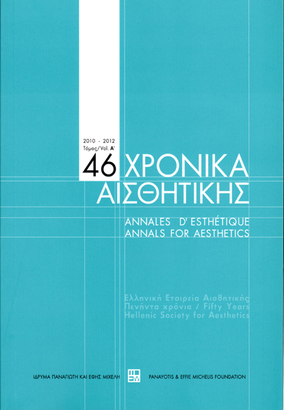Το τυχαίο στη μουσική : το σημερινό ενδιαφέρον για το τυχαίο στην τέχνη
Part of : Χρονικά αισθητικής : ετήσιον δελτίον της Ελληνικής Εταιρείας Αισθητικής ; Vol.Β, No.1, 1963, pages 160-171
Issue:
Pages:
160-171
Parallel Title:
Chance elements in music : (a lecture illustrated by recorded examples of music)
Author:
Abstract:
After reviewing the recent interest in chance elements as used in contemporary painting, sculpture and other arts, and, most particularly, in the music of a growing number of composers during the last ten years or so, the author stresses the fact that chance elements ( most frequently in the form of free improvisation ) have played a considerable role, from primitive music to the high oriental musical cultures and, in the West, from the Middle Ages and Renaissance to Baroque and even early classical music. Since Beethoven, however, the role of such elements has been greatly reduced, until, in the developments of serial music after World War II, almost complete predetermination made the role of the performer superfluous, leading, along one line of evolution, to tape (electronic) music, which comes into being without the mediation of « interpreters ». As a reaction thereto, several attempts to reintroduce the performer as a manipulator of chance ( also called aleatory, random, indeterminate, unpredictable, probabilistic, stochastic, etc.) elements and techniques have been made since the early fifties. Such elements may appear in the process of composition, in the nota- tional techniques (or, more generally in the communication between composer and performer), in performance techniques or, later still, in sound modifications occuring after the performance (room acoustics, use of electroacoustic devices and the like) : the random character of such elements may be guaranteed either by exact procedures (dice, extracting of balls from urn, statistical tables of random numbers, electronic computers), or by approximate ones, usually involving « random » psychologic reactions of the performer. Extremely ingenious and diversified techniques and styles in the use of chance elements have recently been developed ; such elements are always used (being more or less restricted or widespread, in each work according to the case), in such a way that they cannot possibly be precisely predetermined. There are several reasons for introducing them, such as the desire to give a greater freedom to the composition, the wish to secure the collaboration of the perfomer in the shaping of the work and thus have the advantage of the participation of his personality, or to arrive at a multiform statement of the composition, thus enriching it though the diversity of each and every performance, and the like. Among the contemporary trends reviewed, those developed by J. Cage are mentioned first (since they represent the broadest spectrum of possibilities explored by any single composer) : then the work of K. Stockhausen, P. Boulez, L. Nono, L. Berio, M. Feldman, E. Brown, G. Ligeti, S. Bussotti, etc., in this direction is mentioned, with sidelights on graphic music and on electronic music using random elements ( L. Hiller ) as well as on group improvisation ( L. Foss ). Greece’s achievements are particularly stressed : I. Xenakis with his thorough and exacting mathematical treatment of probabilistic, or « stochastic » music, associated with techniques involving set theory, game theory, etc. ; A. Lo- gothetis, with his graphic music, frequently involving a new notational system ; A. Kounadis and N. Mamangakis. Finally, the assertion is made that aleatory music has already produced compositions of outstanding merit and originality, and that, contrary to widespread opinion, this movement is still in its early stages of development and may well evolve so as to constitute an important chapter in the history of contemporary music.
Subject:
Subject (LC):
Keywords:
αυτοσχεδιασμός
Notes:
Διάλεξη εικονογραφημένη από ηχογραφημένα μουσικά παραδείγματα, που έγινε στην Ελληνική Εταιρεία Αισθητικής στις 13 Φεβρουάριου 1963




